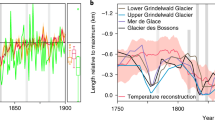Summary
¶Analysis of available data shows that the duration of the glacial/interglacial cycle is determined by the time for the ocean to go through one major temperature cycle. At the start of an interglacial period, clear skies with consequent release of CO2 from the ocean, warms the atmosphere, which in turn eventually warms the ocean to its maximum. Cloudy skies then cause the climate (land and air temperature) to cool and the CO2 to be reabsorbed to start glaciation preliminaries. The albedo feedback effect of the glacial ice, a relatively warm ocean, which produces enhanced cloud cover, and the increased solubility of CO2 in cold seawater ensure a long period of glaciation. Glacial periods end when pack ice spreads out on the ocean cooling it until reduced cloud cover once again allows the Sun’s heat, unreflected by cloud cover, to melt the ice and release CO2 back into the atmosphere.
Similar content being viewed by others
Author information
Authors and Affiliations
Additional information
Received May 22, 2002; accepted June 20, 2002
Rights and permissions
About this article
Cite this article
Bell, L. Ice Age mystery: a proposed theory for the cause of long term climate change. Theor. Appl. Climatol. 74, 235–244 (2003). https://doi.org/10.1007/s00704-002-0710-8
Issue Date:
DOI: https://doi.org/10.1007/s00704-002-0710-8




